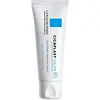What's inside
What's inside
 Key Ingredients
Key Ingredients

 Benefits
Benefits

 Concerns
Concerns

 Ingredients Side-by-side
Ingredients Side-by-side

Coco-Caprylate/Caprate
EmollientGlycerin
HumectantWater
Skin ConditioningAlmond/Borage/Linseed/Olive Acids/Glycerides
AntioxidantPolyglyceryl-6 Distearate
EmulsifyingJojoba Esters
EmollientOryza Sativa Starch
AbsorbentCetyl Alcohol
EmollientGlyceryl Stearate
EmollientHelianthus Annuus Seed Oil Unsaponifiables
EmollientGlyceryl Caprylate
EmollientPolyglyceryl-3 Beeswax
EmulsifyingSodium Stearoyl Glutamate
CleansingBenzyl Alcohol
PerfumingParfum
MaskingHippophae Rhamnoides Oil
EmollientTocopherol
AntioxidantMagnesium Carboxymethyl Beta-Glucan
Skin ConditioningDehydroacetic Acid
PreservativeEclipta Prostrata Extract
Skin ConditioningEclipta Prostrata Leaf Extract
Skin ConditioningMoringa Oleifera Seed Oil
EmollientHelianthus Annuus Seed Oil
EmollientRosmarinus Officinalis Leaf Extract
AntimicrobialCitronellol
PerfumingGeraniol
PerfumingLimonene
PerfumingLinalool
PerfumingCoco-Caprylate/Caprate, Glycerin, Water, Almond/Borage/Linseed/Olive Acids/Glycerides, Polyglyceryl-6 Distearate, Jojoba Esters, Oryza Sativa Starch, Cetyl Alcohol, Glyceryl Stearate, Helianthus Annuus Seed Oil Unsaponifiables, Glyceryl Caprylate, Polyglyceryl-3 Beeswax, Sodium Stearoyl Glutamate, Benzyl Alcohol, Parfum, Hippophae Rhamnoides Oil, Tocopherol, Magnesium Carboxymethyl Beta-Glucan, Dehydroacetic Acid, Eclipta Prostrata Extract, Eclipta Prostrata Leaf Extract, Moringa Oleifera Seed Oil, Helianthus Annuus Seed Oil, Rosmarinus Officinalis Leaf Extract, Citronellol, Geraniol, Limonene, Linalool
Water
Skin ConditioningHydrogenated Polyisobutene
EmollientDimethicone
EmollientGlycerin
HumectantButyrospermum Parkii Butter
Skin ConditioningPanthenol
Skin ConditioningButylene Glycol
HumectantAluminum Starch Octenylsuccinate
AbsorbentPropanediol
SolventCetyl PEG/PPG-10/1 Dimethicone
EmulsifyingTristearin
Skin ConditioningZinc Gluconate
Skin ConditioningMadecassoside
AntioxidantManganese Gluconate
Skin ConditioningMagnesium Sulfate
Disodium EDTA
Copper Gluconate
Skin ConditioningAcetylated Glycol Stearate
EmollientPolyglyceryl-4 Isostearate
EmulsifyingSodium Benzoate
MaskingPhenoxyethanol
PreservativeChlorhexidine Digluconate
AntimicrobialCI 77891
Cosmetic ColorantWater, Hydrogenated Polyisobutene, Dimethicone, Glycerin, Butyrospermum Parkii Butter, Panthenol, Butylene Glycol, Aluminum Starch Octenylsuccinate, Propanediol, Cetyl PEG/PPG-10/1 Dimethicone, Tristearin, Zinc Gluconate, Madecassoside, Manganese Gluconate, Magnesium Sulfate, Disodium EDTA, Copper Gluconate, Acetylated Glycol Stearate, Polyglyceryl-4 Isostearate, Sodium Benzoate, Phenoxyethanol, Chlorhexidine Digluconate, CI 77891
 Reviews
Reviews

Ingredients Explained
These ingredients are found in both products.
Ingredients higher up in an ingredient list are typically present in a larger amount.
Glycerin is already naturally found in your skin. It helps moisturize and protect your skin.
A study from 2016 found glycerin to be more effective as a humectant than AHAs and hyaluronic acid.
As a humectant, it helps the skin stay hydrated by pulling moisture to your skin. The low molecular weight of glycerin allows it to pull moisture into the deeper layers of your skin.
Hydrated skin improves your skin barrier; Your skin barrier helps protect against irritants and bacteria.
Glycerin has also been found to have antimicrobial and antiviral properties. Due to these properties, glycerin is often used in wound and burn treatments.
In cosmetics, glycerin is usually derived from plants such as soybean or palm. However, it can also be sourced from animals, such as tallow or animal fat.
This ingredient is organic, colorless, odorless, and non-toxic.
Glycerin is the name for this ingredient in American English. British English uses Glycerol/Glycerine.
Learn more about GlycerinWater. It's the most common cosmetic ingredient of all. You'll usually see it at the top of ingredient lists, meaning that it makes up the largest part of the product.
So why is it so popular? Water most often acts as a solvent - this means that it helps dissolve other ingredients into the formulation.
You'll also recognize water as that liquid we all need to stay alive. If you see this, drink a glass of water. Stay hydrated!
Learn more about Water